
10 minute read
Voices from the Fleet
from Wavelength #80
MV APAGEON I, ASD Juaton, Edgar Charles S., currently on board MV APAGEON, belonging to the CENMAR crew since 2013, have a lot of good memories with our Company, especially during the company forums that are held in Manila, Philippines. This is the most awaited event of the Company because this is where we have a chance to meet and greet the Greek Management personnel and all the Filipino crew. First day of the CENMAR Forum is when various topics are being addressed. CENMAR highest ranking officials present their topics, whether it is about Navigation, Quality and Safety, Marine Operations, Technical, or Manning and Training. Also, I must admit the food during lunch is awesome. The second day is my favourite. After completing the presentations, it is time for the group photos.
M/V CE-Duke I have been with the Company since 2013 and my memorial vessel is M/V CE-Duke, where I served twice as a Chief Officer in 2013-2014 and 2016-2017. In my bright memory is the visit of our Eng. Supt. Mr. Christos Chatzigiaklou (CCH) in Lianyungang, China at the end of February 2014, where we inspected all ballast tanks, all cargo holds together and I reported to him all true vessel's present condition. It was a nice inspection and visit.
Advertisement
Fleet Supervisor Technical Mr. Chatzigiaksoglou in Lianyungang, China
M/V Philippos A.
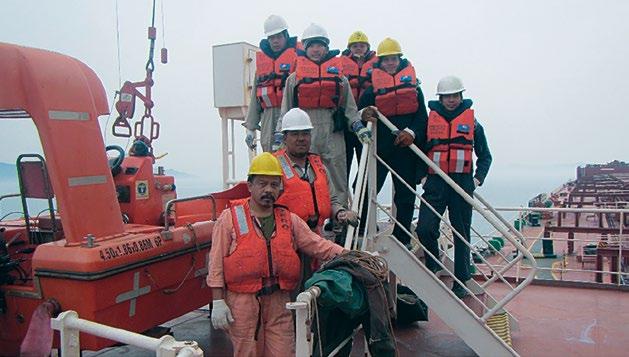
Rank and Name, in order, with pride and still working with the Company are as follows: 3rd Engr. PIMENTEL NELSON GINGOYON, Chief Officer MENDONES WILLIE GALVAN now Master Mariner, 2nd Mate GALLEON ADRIAN PAUL VICENTE now Master Mariner, 3rd Mate QUITAN ROGELIO III BASILIO now 2nd Officer, ASD DUMENCEL JUN JUAN now 3rd Officer, Oiler REJANO JOEL MARTINEZ, Mman IGNACIO JO-AD ESTRADA Then, before the end of the day, there is a basketball game that all Filipino crew enjoy. Here is one of the photos that I kept because for me this is a memorable experience. Thank you very much and looking forward to other great memories with the Company. Truly yours, ASD Juaton, Edgar Charles
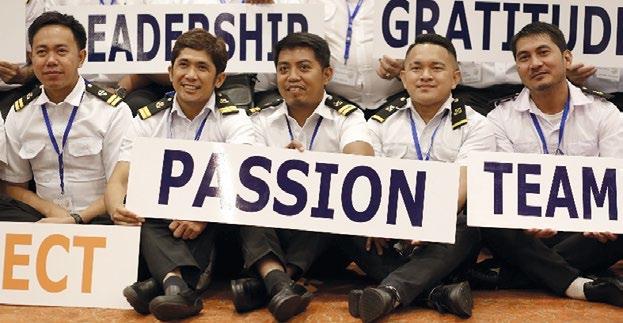
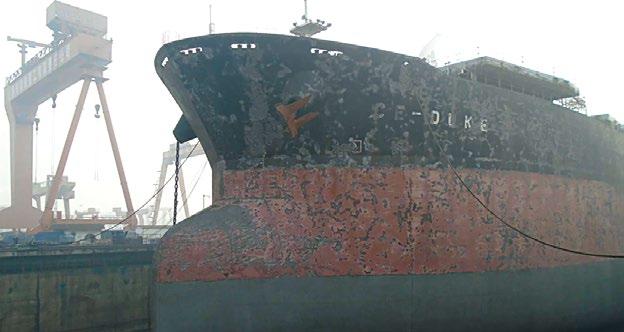
M/V Duke at Shanhaiguan Shipyard
I also performed a dry dock on M/V CE-Duke in 2016 and during that time got experience and knowledge from attending Supt. Eng. Mr. Michalis Maritsas (MAR). It was a good and interesting time at Shanhaiguan Shipyard, where we worked and talked with all Office staff, Technicians and Superintendents. Finally, I was the last Officer of the Company who stepped out from M/V CE-Duke after the vessel was sold in 2017. It was a fetching experience. M/V CE-Duke was demanding, but I learned a lot during my stay on this vessel.
On the 26th April 2014 during the calm weather at Dangjin, South Korea Anchorage No. 2 the above mentioned officers and crew demonstrated with confidence the proper launching and maneuvering into the water of both Rescue Boat and Free Fall Lifeboat to the rest of the observing officers and crew of MV Philippos A. under the Command of Capt. Marvin R. Sagum, the provider of the said photos. Blessed are all those officers and crew who share their knowledge and experienced to the fleet with confidence.
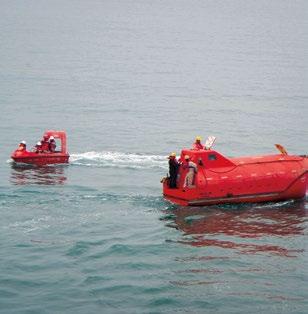
Brgds/Master M/V Smyrna
The Inuit
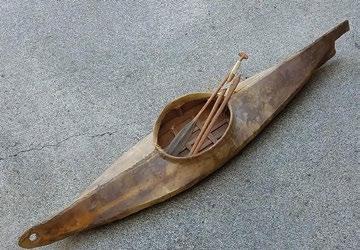
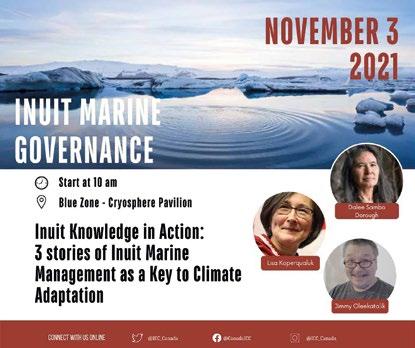
The Inuit are indigenous people who live in Arctic and subarctic regions. With an estimated population of 180,000, they inhabit areas of Arctic Canada, Greenland, Alaska and Russia. Although the origins of the Inuit have not been accurately determined, it is known that they have been eking out an existence in the extreme cold for thousands of years. More precisely, they have been around for at least 3800 years as evidenced in an archaeological site in Labrador. Due to their settlements being located in coastal areas, the Inuit culture is primarily based on their maritime activities. In the past they had to construct a craft with limited materials so that they could hunt seals, walrus and whales in the open ocean and among ice floes. Most of these craft, known as kayaks, were simple skin-on-frame constructions with scraped seal skins covering a driftwood frame lashed together with seal ligaments. The risks of using such a flimsy craft in dangerous waters were mitigated by the Inuit ability to navigate and the speed and seaworthiness of their kayaks. Their seafaring skills even impressed European explorers who witnessed their maritime exploits. In addition to hunting maritime mammals, they caught fish and tracked caribou on dogsleds. Today, the dogsleds have been largely replaced by snowmobiles and the bows and arrows used to make the kill have given way to rifles. At sea, their traditional craft frames are glued with epoxy resins and covered by nylon fabric. Fibreglass is another material that is now often used in modern kayak building. Such changes are indicative of the need for Inuit peoples to adapt to the demands of our globalized world. In certain cases the Inuit have been forced to take drastic steps. For instance, many have abandoned their nomadic hunting culture to work in mines and oilfields. On the other hand, there are those working tirelessly to revitalize traditional Inuit culture in North America. This has involved forming cooperatives to market handicrafts, produce and tourism as well as becoming politically organised. Founded in 1977, the pan-Arctic Inuit Circumpolar Council (ICC), a non-governmental organisation, has helped strengthen unity among the Inuit, promoted Inuit rights and protected Inuit culture. The Inuit have also been able to advance their rights to self-determination, especially in Slope Borough, Alaska and in Nunavut and Nunatsiavut in Canada. Put simply, they were given a voice that was also heard at the climate change talks in Glasgow (COP26) and by the IMO in January 2022, when they were included in talks regarding underwater ship noise pollution in the Northwest Passage. Indeed, the IMO agreed to take into account indigenous knowledge in their development of a plan to reduce such pollution created by ship traffic. Another occasion on which Inuit knowledge in the form of oral history has proved invaluable was the discovery of Erebus in 2014. Stories of the Franklin expedition passed down through generations of the Nesilik Inuit of King William Island in conjunction with modern science and exploration techniques led Parks Canada to conclude their search for this vessel. Unfortunately, those on board Erebus and Terror in the
1845 expedition who died from botulism, scurvy, exposure and cannibalism were not able to benefit from Inuit help. One reason for this was that the crews did not find the indigenous A traditional Inuit kayak people until it was too late. When their paths crossed, the crew had already lost their minds. As a result, the Inuit, who had never seen Europeans before were terrified of strange beings who were babbling in a language they had never heard before. Despite their fear, the Inuit did offer some assistance to a few explorers. They constructed an igloo and left them food in the form of seals, but to no avail. When the Inuit returned, they found the seals untouched and the igloo full of lost souls. Conversely, prior to Robert Peary’s expedition to the North Pole, the explorer and his support network lived with Greenland Inuit known as the Inughuit. He gained vital knowledge from his hosts during his stay. This served him well in his journey to the Pole, but it was ultimately the assistance of four Inuit in his party that allowed him to succeed in his expedition along with Matthew Henson. Unsurprisingly, Egingwah, Ootah, Ooqueah and The four Inuit guides without whom Peary would not have Seegloo, without whom Peary would reached the Pole not have reached the North Pole, were Courtesy of: www.berkshiremuseum.org never formally acknowledged for the vital role they played. Poster from COP26: Inuit voices being heard Source: www.inuitcircumpolar.com Over the past 50 years, the Inuit have faced great challenges. Social and economic inequities, political marginalization, shrinking communities together with climate change have posed a serious threat to Inuit culture. Thankfully, agreements with the Canadian government and the formation of the ICC have given the Inuit a way of revitalizing their culture. Moreover, their voice is now being heard to the benefit of both Inuit communities and those organizations willing to heed what they have to say. Sources: www.britannica.com, www.kayakbuilding.com, www.wncmagazine.com www.deeply.thenewhumanitarian.org, www.athropolis.com, www.rmg.co.uk www.pajiba.com, www.nunatsiaq.com, www.inuitcircumpolar.com
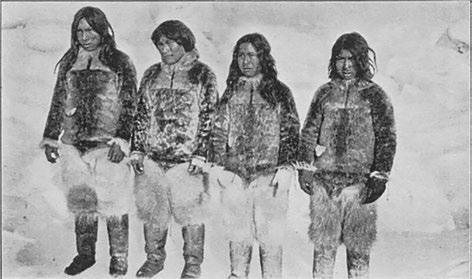
Endurance Found
Deruny
In 1915, Ernest Shackleton’s exploration vessel, Endurance, was trapped in sea ice. There, she remained for several months before being crushed by shifting ice and sinking to 10,000ft (3048m) below the surface. Ever since Endurance sank, there had been speculation as to where the ship lay and whether she would ever be found. Such was the interest in locating her that a project, Endurance 22, was initiated by the Falklands Maritime Heritage Trust (FMHT). With the aid of a South African icebreaker, Aghulhas II, and several remote controlled submersibles, experts from the FMHT finally found the wreck in March this year. It was aptly a triumph of endurance on the part of those involved in the search as they had to battle shifting sea ice, blizzards and temperatures as low as -18oC. The wreck was spotted while an area containing several promising targets was being combed. Following the discovery, a record of the stricken ship and the surrounding debris was painstakingly compiled. Images have revealed that Endurance is almost in the same condition as she was when she disappeared. There is some damage to the bow and the masts are down, but the hull and timbers have suffered little deterioration. The only real change has been the colonization of the vessel by such marine species as sea squirts, anemones and sponges. Fortunately, the waters where she lies are too cold for woodmunching aquatic worms. Other things that have been spotted in the images captured by the submersibles include boots and crockery, and while there are those who would jump at the chance to examine the artefacts on board, none will be removed from Endurance. This is because the wreck has been designated a monument under the International Antarctic Treaty and is, therefore, not to be disturbed at all.
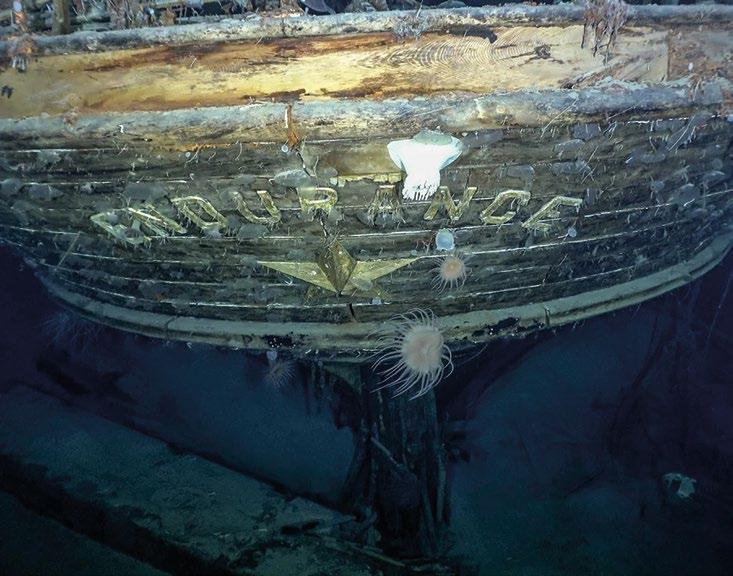
Source: www.smithsonianmag.com
Sources: www.bbc.com, www.smithsonianmag.com
Food Culture

Source: anya.photosvit.com Deruny is the name given to a potato pancake dish in Ukraine. Once cooked mainly on Sundays or on festive occasions, the Ukrainian comfort food is served on a much more regular basis these days. The small pancakes with their browned crusty exterior and soft moist interior have become part and parcel of Ukrainian cuisine, especially in the north, where a deruny festival is held in Korosten in early September. The basic ingredients for deruny are potatoes, onions, eggs, flour, salt and pepper, but as there are many recipe variations, these can be supplemented with such ingredients as mushrooms, cabbage, carrots, hard cheese and even ground meat. The pancakes are cooked in sunflower oil and served hot with sour cream. As well as achieving comfort food status, deruny has literally saved thousands of lives. During the Ukrainian Terror Famine of 1932-3, people relied on the dish for their very survival. During that period any ingredients available like linden leaves, sorrel leaves or left over nuts and grains found their way into the pancakes. Like many iconic dishes, deruny has gone international. In the aforementioned festival held in Korosten, chefs from different countries exhibit their deruny-making skills in competitions. Outside Ukraine, there is a festival at the Ukrainian Embassy in The Hague. At this festival, master classes are held, one of which was given by the Ambassador of Ukraine to the Netherlands in 2017. With the humble potato as its main ingredient, deruny has become one of Ukrainian cuisine’s most important dishes. Not only has it saved lives but it has also become a medium through which chefs can exhibit their culinary skills and pass them on to those deruny lovers who wish to take their potato pancake creations to another level.
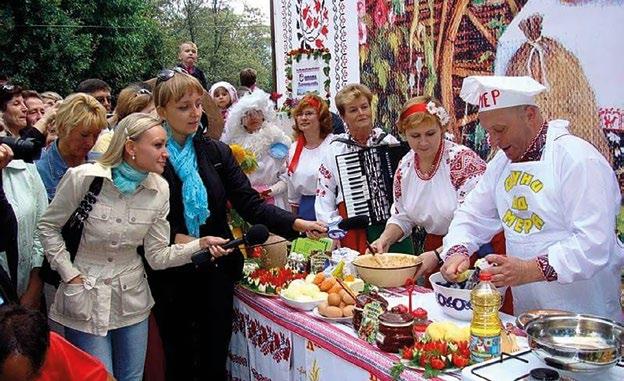
Deruny Festival in Korosten
Sources: www.authenticukraine.com, www.ukrainian-recipes.com www.chefspencil.com, www.ukrainiantour.com, www.ukrinform.net www.discover-ukraine.info








